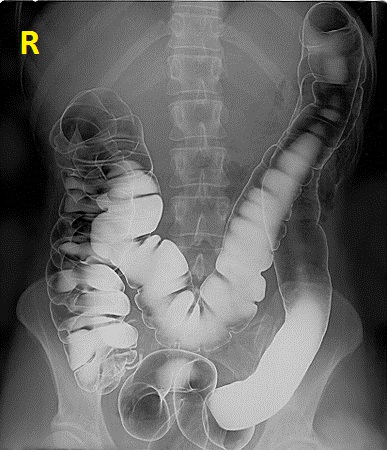Constipation other imaging findings
|
Constipation Microchapters |
|
Diagnosis |
|---|
|
Treatment |
|
Case Studies |
|
Constipation On the Web |
|
American Roentgen Ray Society Images of Constipation |
Editor-In-Chief: C. Michael Gibson, M.S., M.D. [1]; Associate Editor(s)-in-Chief: Eiman Ghaffarpasand, M.D. [2]
Overview
Barium enema may be helpful in diagnosing underlying diseases of constipation. Findings on a barium enema suggestive of constipation are redundant sigmoid colon, megacolon, megarectum, extrinsic compression, and intraluminal masses. Defecography may be helpful in diagnosing underlying diseases causing constipation. Findings on a defecography suggestive of constipation are poor activation of levator ani muscle, prolonged retention or inability to expel the barium, absence of a stripping wave in the rectum, mucosal intussusceptions, or rectocele. The transit time of the colon can be measured by means of various methods, include radiopaque marker ingestion, radioisotope and scintigraphy study, and wireless motility capsule.
Other Imaging Findings
 |
Barium enema
- Barium enema visualizes bowels (rectum, colon, and lower portions of small intestine), using radiopaque enema through the anus.[2]
- Barium enema may be helpful in diagnosing underlying diseases causing constipation. Findings on a barium enema suggestive of constipation include:[3]
- Redundant sigmoid colon
- Megacolon
- Megarectum
- Extrinsic compression
- Intraluminal masses
- Barium enema is found to be inefficient for diagnosing organic lesions in colorectal portions of patients with constipation.[4]
Defecography
- Defecography is an fluoroscopic method of visualizing actual process, rate, and completeness of fecal evacuation along with anorectal abnormalities, and evaluates anorectal muscle contractions and relaxation.[5]
- The procedure consists of infusing 150 cc contrast with the same consistency as stool into the rectum, asking the subject to evacuate and expel the barium. Fluoroscopic study is done during the evacuation.
- Defecography may be helpful in diagnosing underlying diseases causing constipation. Findings on a defecography suggestive of constipation include:[6]
- Poor activation of levator ani muscle
- Prolonged retention or inability to expel the barium
- Absence of a stripping wave in the rectum
- Mucosal intussusceptions
- Rectocele
- Defecography revealed modest correlation with symptoms of the patients, while it has multiple disadvantages, include:[5]
- Radiation exposure
- Embarrassment
- Interobserver bias
- Inconsistent methodology
Colorectal transit study
- Colorectal transit study shows how well food moves through the colon, since the patient recall of bowel movements is mostly not reliable.
- The transit time of the colon can be measured by means of various methods, include radiopaque marker ingestion, radioisotope and scintigraphy study, and wireless motility capsule.
Radiopaque markers
- Radiopaque markers are plastic beads or rings are been contained in a edible capsule.
- There are 20-50 rings in each capsule. There are two methods of diagnosis:
- Serial abdominal X-rays are taken after ingestion of the Sitzmarks capsule, until all the rings clears from bowels.
- Single abdominal X-ray on the day 5 (after 120 hours) [preferred method due to less radiation exposure].
- On the day 5, more than 20% rings (more than 6 markers) remaining in the bowels is diagnostic of delayed colonic transit.[7]
 |
Colonic transit scintigraphy
- Scintigraphy method of measuring colonic transit time is visualizing the bowels using gamma-camera in patients who has been administered indium-111-labeled polystyrene pellets.[8]
- Primary time of imaging is after 24 hours and the normal range of geometric center is 1.7-4.0. Higher amounts of geometric center reflects delayed transit in colon.[2]
- Scintigraphy application in patients with refractory constipation after laxative treatment is increasing, but high price and low availability prevent the scintigraphy to be the diagnostic study of choice.[9]
Wireless motility capsule (WMC)
- Wireless motility capsule (WMC) is a non-invasive method for determining not only colonic transit time, but also the primary characteristics of gastric emptying and small intestine transit time.[10]
- WMC measures the temperature (T), pH, and pressure (P) changes during the gut passage. Therefore, transit time can be studied in each part of gastrointestinal tract, regarding different levels of T, pH, and P.
- WMC is proved to have a reasonable sensitivity in detecting any motility disorder or other underlying diseases causing constipation.[11]
References
- ↑ <"https://commons.wikimedia.org/wiki/File%3AHuman_intestinal_tract%2C_as_imaged_via_double-contrast_barium_enema.jpg">via Wikimedia Commons
- ↑ 2.0 2.1 Rao SS, Meduri K (2011). "What is necessary to diagnose constipation?". Best Pract Res Clin Gastroenterol. 25 (1): 127–40. doi:10.1016/j.bpg.2010.11.001. PMC 3063397. PMID 21382584.
- ↑ Gerson DE, Lewicki AM, McNeil BJ, Abrams HL, Korngold E (1979). "The barium enema; evidence for proper utilization". Radiology. 130 (2): 297–301. doi:10.1148/130.2.297. PMID 104358.
- ↑ Patriquin H, Martelli H, Devroede G (1978). "Barium enema in chronic constipation: is it meaningful?". Gastroenterology. 75 (4): 619–22. PMID 710831.
- ↑ 5.0 5.1 Diamant NE, Kamm MA, Wald A, Whitehead WE (1999). "AGA technical review on anorectal testing techniques". Gastroenterology. 116 (3): 735–60. PMID 10029632.
- ↑ Savoye-Collet C, Koning E, Dacher JN (2008). "Radiologic evaluation of pelvic floor disorders". Gastroenterol. Clin. North Am. 37 (3): 553–67, viii. doi:10.1016/j.gtc.2008.06.004. PMID 18793996.
- ↑ Kim ER, Rhee PL (2012). "How to interpret a functional or motility test - colon transit study". J Neurogastroenterol Motil. 18 (1): 94–9. doi:10.5056/jnm.2012.18.1.94. PMC 3271260. PMID 22323993.
- ↑ Stivland T, Camilleri M, Vassallo M, Proano M, Rath D, Brown M, Thomforde G, Pemberton J, Phillips S (1991). "Scintigraphic measurement of regional gut transit in idiopathic constipation". Gastroenterology. 101 (1): 107–15. PMID 2044899.
- ↑ Maurer AH, Parkman HP (2006). "Update on gastrointestinal scintigraphy". Semin Nucl Med. 36 (2): 110–8. doi:10.1053/j.semnuclmed.2005.12.003. PMID 16517233.
- ↑ Rao SS, Kuo B, McCallum RW, Chey WD, DiBaise JK, Hasler WL, Koch KL, Lackner JM, Miller C, Saad R, Semler JR, Sitrin MD, Wilding GE, Parkman HP (2009). "Investigation of colonic and whole-gut transit with wireless motility capsule and radiopaque markers in constipation". Clin. Gastroenterol. Hepatol. 7 (5): 537–44. PMID 19418602.
- ↑ Lee, Allen; Michalek, Whitney; Wiener, Stephen M.; Kuo, Braden (2010). "T1067 Clinical Impact of a Wireless Motility Capsule – A Retrospective Review". Gastroenterology. 138 (5): S-481. doi:10.1016/S0016-5085(10)62222-6. ISSN 0016-5085.